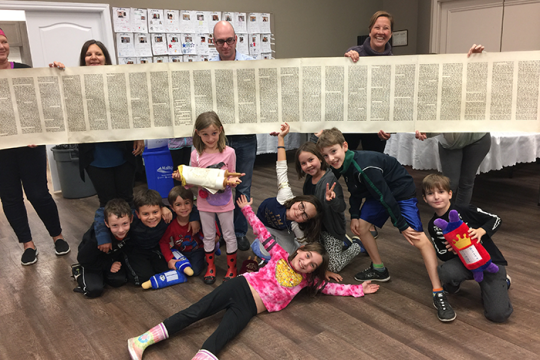Memorialization of deceased relatives and of Jewish martyrs has figured in the liturgical observances of Yom Kippur since the massacre of approximately 8,000 Rhineland Jews at the time of the First Crusade (1096). Indeed, many of the Jewish mourning customs that have continued down to our own day originated in that time and place in response to the emotional challenges faced by the survivors.1 An extensive Jewish memorial literature of chronicles and poetry (particularly liturgical poetry, piyyutim) was created in the wake of those sad events.2
One of those liturgical poems is Eileh Ezkerah (“These do I recall”), which recounts the legend of the Ten Martyrs (aseret harugei malchut) – ten Rabbis (including Rabbi Akiva) who, according to rabbinic tradition, were executed at the time of the Jewish revolt against Rome during the reign of Hadrian (the “Bar-Kochba Revolt” in 132-135 C.E.) for the crime of actively propagating Jewish tradition: teaching Torah and practicing circumcision and other forbidden Jewish rites.
The legend of the Ten Martyrs begins in several scattered talmudic traditions about the martyrdoms of Rabbi Akiva (Babylonian Talmud Berachot 61b), Rabbi Hanina b. Teradion (b. Avodah Zarah 18a), and Rabban Shimon b. Gamaliel and Rabbi Ishmael (Avot deRabbi Natan, recension A, 48; recension B 41). The number ten is formulaic, occurring in the Midrash on Psalms (9:13) and the Midrash on Lamentations (2:2); there is no agreement in the sources on the names of the ten martyrs. The extended legend is medieval. It was particularly elaborated in the Rhineland after the Crusades and exists in at least ten different prose recensions as well as our liturgical poem. In the extended legend, the deaths of the ten Rabbis is explained as atoning for the guilt of the ten sons of Jacob who sold their younger brother Joseph into slavery. (The book of Jubilees, which dates from the late Second Commonwealth period, claims that the sale of Joseph into slavery took place on Yom Kippur and identifies this as the rationale for communal fasting on this day.) Here, then, is a theodicy (that is, a justification of God’s ways) for the martyrdom of the righteous – both at the time of Hadrian and at the time of the Crusades: the deaths of the righteous, pious martyrs effect atonement for the past sins of the people. Additionally (in the prose versions), the deaths of the righteous martyrs provide an ironclad guarantee that, in the future, the wicked kingdom of Rome (=the yoke of Christian rulers) will be destroyed and Israel redeemed.
The poem Eileh Ezkerah was, as we noted, written in Germany in the aftermath of the Crusades. The author identifies himself in an acrostic as “Yehudah,” but we do not otherwise know who he was. The poem is a selichah (a petition for forgiveness), belonging to that genre of penitential prayers and hymns that we discussed several weeks ago and that characterize the liturgy of Yom Kippur and the month leading up to it. It appears in the traditional Yom Kippur Musaf service directly after Seder Ha’avodah, according to the following logic:
The traditional Seder Ha’avodah ends with a series of laments, penitential prayers, and confessions dealing with the loss of the Temple and its rituals: “On account of our sins and the sins of our ancestors we are lacking all of these things,” followed by, “Remember, Lord, Your compassion and loving-kindness . . .We have sinned, our Rock; forgive us, our Creator.” Eileh Ezkerah follows immediately upon this. Its first line is a poetic inversion of Psalm 42:5 – “When I think of this, I pour out my soul,” understood by the poet as, “When I call to mind/remember these ones . . .” The poem goes on to recount the martyrdom of the ten righteous Rabbis, whose deaths are understood to have atoned for the sins of the people (although in one verse, the angels cry out bitterly: “Is this the reward of Torah?” – to which a divine voice responds, “This is my decree: Accept it or else!”; this interchange is based on, but is more unrelenting than, b. Berachot 61b). Every verse is followed by the (interpolated) refrain: “We have sinned, our Rock; forgive us, our Creator.” The poem concludes as follows:
All this befell us – we have told it, repeatedly,
pouring out our crushed, mournful hearts;
listen to our supplications from heaven above,
Adonai, Adonai, compassionate and gracious God.O Gracious One, look down from Your heights,
see the spilled blood of the righteous, their vital essence,
from Your concealed place behold this
and remove the stains of sin,
God, King, who sits upon a throne of compassion.3
Suffice it to say that none of this is promising material for a Reform Yom Kippur machzor! The theology of the poem is, to say the least, highly problematic. Indeed, the poem was dropped from all Reform prayer books before the Holocaust. But it was precisely the impact of the Holocaust that prompted Rabbis John Rayner and Chaim Stern to include an extended martyrology in the Musaf service of their 1973 British Liberal machzor, Gate of Repentance, following immediately upon Seder Ha’avodah, which included (only) the first verse of this poem in a collage of Hebrew texts – biblical, rabbinic, and modern – that respond to various historical catastrophes and mourn their victims.4
This material was then carried forward, in a slightly adapted form, into the North American CCAR Gates of Repentance (1978). The sensibility reflected in this liturgical adaptation/creation is very much that of the generation that lived through the Second World War, the Holocaust, and the founding of the State of Israel – scars that were re-opened in the days leading up to the Six Day War in 1967 and the prolonged Yom Kippur War of 1973. It remains to be seen how a younger generation, further removed from these experiences, will reinterpret these issues, and how a new Reform machzor will reframe these materials.
- This is spelled out in a fascinating way by Ivan G. Marcus, The Jewish Life Cycle: Rites of Passage from Biblical to Modern Times (Seattle: University of Washington Press, 2004), 221-244.
- See, for example, Jeremy Cohen, Sanctifying the Name of God: Jewish Martyrs and Jewish Memories of the First Crusade )Philadelphia: University of Pennsylvania Press, 2004), and Susan L. Einbinder, Beautiful Death: Jewish Poetry and Martyrdom in Medieval France (Princeton: Princeton University Press, 2002).
- The translation is that of Rabbi Jonathan Sacks, from the Koren Yom Kippur Mahzor (2012).
- Besides the first verse of Eileh Ezkerah, these texts include the first verse of Eli Tsiyon, the well-known dirge (kinah) from the liturgy for the Ninth of Av; the poem “An Oath,” by the Israeli poet Abraham Shlonsky; and a series of thematically relevant biblical verses: Joel 1:2ff., Is. 64:10, 22:4, 9:17. 24:4-6a. (All of these selections except for the biblical verses were taken over into the CCAR Gates of Repentance, although the Shlonsky text is only given there in English.) Rayner and Stern note that they took their inspiration here partly from Mordecai Kaplan’s 1948 Yom Kippur Prayer Book, which follows Eileh Ezkerah with a series of texts commemorating the martyrs of the Holocaust (the first of which is Hannah Senesh’s poem, Ashrei hagafrur/”Blessed is the Match.”
Dr. Sarason is Professor of Rabbinic Literature and Thought and the Associate Editor of the Hebrew Union College Annual. He was ordained at HUC-JIR.



